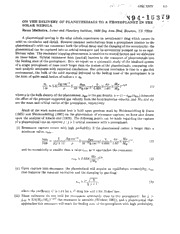
NASA Technical Reports Server (NTRS) 19940011906: On the delivery of planetesimals to a protoplanet in the solar nebula PDF
Preview NASA Technical Reports Server (NTRS) 19940011906: On the delivery of planetesimals to a protoplanet in the solar nebula
_ _c_ -" LPSC XXIV 925 N94-1o379 ON THE DELIVERY OF PLANETESIMALS TO A PROTOPLANET IN THE - - SOLAR NEBULA / ,- Renu Malhotra, Lunar and Planetary Institute, 3600 Bay Area Blvd, Houston, TX 77058 A planetesimal moving in the solar nebula experiences an aerodynamic drag which causes its orbit to circularise and shrink. However resonant perturbations from a protoplanet interior to the planetesimal's orbit can counteract both the orbital decay and the damping of the eccentricity: the planetesimal can be captured into an orbital resonance and its eccentricity pumped up to an equi- librium value. The resonance trapping phenomenon is sensitive to several factors and we elaborate on these below. Orbital resonances form (partial) barriers to the transport of planetesimals into the feeding zone of the protoplanet. Here we report on a systematic study of the idealised system of a single protoplanet of mass much larger than the masses of the planetesimals, comparing rele- vant analytic estimates with numerical simulations. Our principal conclusion is that in a gas-rich environment, the bulk of the solid material delivered to the feeding zone of the protoplanet is in the form of quite small bodies of radius s < so, s_.._o_ 5.5(3g-cm-3)( Psu ( rl .ff ap )(Mp)_3/7 (1) 1m p lO-lOg_cm-3 0.005 j_ 1AU ""M s " where p is the bulk density of the planetesimal, Ps_ is the gas density, 77= (1 - Vs_s/Vkep) measures the offset of the pressure supported gas velocity from the local keplerian velocity, and MR and ap are the mass and orbital radius of the protoplanet, respectively. Much of the work summarized here is built upon previous work by Weidenschilling & Davis (1985) and Weidenschilling (1987) on the phenomenon of resonance capture; we have also drawn upon the analysis of Adachi etal (1976). The following points can be made regarding the capture of a planetesimal into an exterior j :j + 1 orbital resonance with a protoplanet: (i) Resonance capture occurs with high probability if the planetesimal radius is larger than a minimum value, 8rain, Pgas _] ap Mp ]-1 Slktamin _- j(j 2+-_( 3g-cmp-3 )( 10- ,Og-cm-3 (0.--_ )( 1---_)( M-_-_" ' (2) and its eccentricity is smaller than a value ecrit as it approaches the resonance: Mp _1/3 (3) ecrit --_0.023(j--_) . (ii) Upon capture into resonance, the planetesimal will acquire an equilibrium eccentricity, eeq, that balances the resonant excitation and the damping by gas drag: eeq --_C Vfj_ + 1' (4) where the coefficient C is 1.14 for a v2 drag law and 1 for Stokes' law. (iii) These estimates do not hold for resonances arbitrarily close to the protoplanet: for j > jcrit _, 0.4(MR(cid:0)M®) -:/r the resonance is unstable (Wisdom 1981), and a planetesimal that approaches this resonance will reach the feeding zone of the protoplanet with high probability. 926 LPSCXXIV DELIVERY OF PLANETESIMALS TO A PROTOPLANET : R. Malhotra Since larger planetesimals are more easily captured into resonance, they may reach the protoplanet only if their orbital eccentricities are sufficiently high to allow a diffusion past the orbital resonances. However, due to the efficacy of eccentricity-damping by gas drag, only a small fraction of the larger planetesimals is likely to fall in this category. Weidenschilling & Davis (1985) have suggested that the resonance capture of the larger planetesimals will enhance their collision rates. If a collision imparts a sufficiently high velocity kick to a planetesimal, the resonance can be unlocked. We estimate the magnitude of this kick to be _v _ Mp ,1/2 vk,- -- . (5) However, unless the particle is comminuted, it is very likely to be trapped into the next orbital resonance as its orbit decays. Thus, only those particles that are comminuted to a size sufficiently small that they can escape being captured into all j :j + 1 resonances with j < jcrit will be easily delivered to the protoplanet, so in equation (1) is our estimate of the maximum particle radius that satisfies this condition. References Adachi, I. C.Hayashi and K.Nakazawa (1976) Prog. Theor. Phys. 56 1756-1771. Weidenschilling, S.J. and Davis, D.R. (1985) Icarus 62, 16-29 Weidenschilling, S.J. (1987) Gerlands Beitrage Zur Geophysik 96 21-33. Wisdom, J. (1980) Astron. J. 85 1122-1133.
